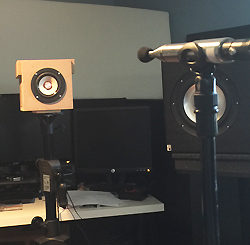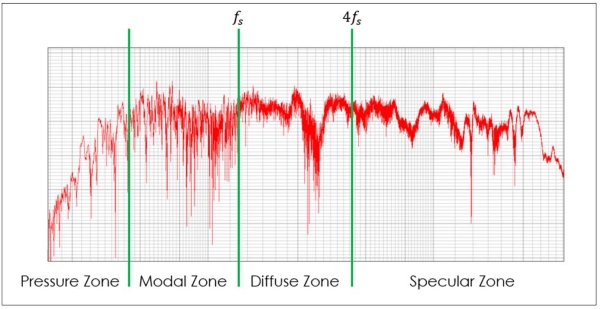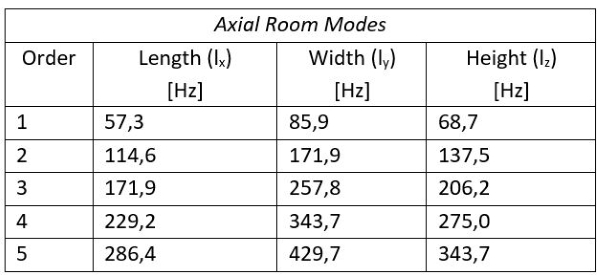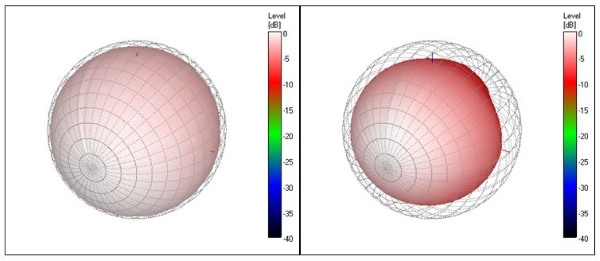
Room Resonances
Room resonances are commonly known as room modes. These are standing waves that happen between two parallel boundaries that are not absorptive, diffusive or reactive at certain frequencies.
When we talk about a room, a question arises: how big is a room and how does that relates to sound? It depends: sound behaves differently depending on its wavelength relative to the room’s dimensions.
Figure 8 shows a frequency response in a room. Pressure zone happens at low frequency where the wavelength is much larger than the room dimensions, below the lowest room mode frequency or c/2L, where L is the longest dimension of the room and c is the speed of sound.
Modal zone is where room modes occur. The room dimension is smaller or equal to the wavelength. Two parallel walls will create axial standing waves. Standing waves in a room can be calculated using the equation below (for axial, tangential, oblique modes):
Where c is the speed of sound propagation in air and l, m, n are integer numbers showing the order of the room modes.
Axial room modes (order: 1,0,0; 0,1,0 and 0,0,1) for a room with dimension 3 m x 2 m x 2.5 m can be calculated as follows:
For example: in the middle of the 3 m length, 57 Hz will be gone due to standing waves, but will be loud/very noticeable at the end of the long walls. Right in the middle of the room, a lot of cancellation occurs due to room resonances and this is commonly known as bass suck/weak bass.
In a cube room (all dimensions are equal), the cancellation between three pairs of wall/floor-ceiling happen at the same modal frequencies. This will create strong resonances at specific frequencies, creating very deep notches and very high peaks in the frequency response.
These notches/cancellations in frequency response can’t be fixed using EQ. Bass trapping can help, and good room ratio will result in good modal frequency spacing (less noticeable).
The resonant frequencies and distribution of room modes are mostly determined by the room’s dimensions. Just because the room is not symmetrical and no parallel walls existed, standing waves can occur among several walls (harder to predict). The loudspeaker position will affect the excitation of room modes and the positions of the listeners will affect the audibility of the room modes.
Schroeder frequency, noted by fs sign in Figure 8, is the transition between the modal zone to the diffuse zone. In the diffuse zone, the room dimensions are large enough that there is a sufficient density of modes. A diffuse field has equal energy density at all points in the room and good probability that sound will arrive from any directions.
Where T60 is the reverberation time (it is known as decay time for a small room) and V is the room volume in m3.
In general, the room is considered “big” for frequencies above 300 Hz. At mid/high frequencies, back and forth reflections between two parallel surfaces can be noticeable. This is called flutter echoes or a series of regularly spaced reflections separated by a constant time. The peak in comb filter can be much sharper compared to a single strong reflection.
Lack of Diffusion / Sound Envelopment
Specular zone happens at frequencies above four times the Schroeder frequency as shown in figure 8. A specular reflection can be thought of as a mirror-like reflection and can create a strong comb filter in frequency domain.
Although the common decay time of a treated vs untreated room can be roughly the same, the sonic impression can be very different (note: the term decay time is used in a small room and shall be differentiated from reverberation time/T60). Using proper placement of absorbers and diffusers, the density of early/late reflections can be modified to create different sound envelopment experience.
Sound envelopment is a sense of space. To create this experience in a small room, reflections can be diffused. Diffusers are commonly used to increase diffusivity in a small room, hence also increasing/modifying the sound envelopment. In movies, the use of multichannel audio is widely known to provide the envelopment to immerse the listener to the space shown on the screen.
In a loudspeaker’s sound reproduction, sound waves spread differently at different frequencies, becoming less directional with decreasing frequency. Figures 9 and 10 show sound dispersion balloons for a 2-way loudspeaker with 8-inch woofer and a tweeter in a small horn.
This explains why a loudspeaker needs to be aimed properly at the listeners (high-frequency radiation tends to focus to the front of loudspeaker) and subwoofers can be placed anywhere. Directivity also exists in other sound sources such as the human voice or acoustic instruments. Various sound source types, placement or orientation can excite/energize a room differently at different frequencies.
A sense of sound envelopment comes from late-arriving reflections. Listening to a live band in a small room can give more intimacy, which is a sense of being close to the stage/band, but probably less sound envelopment. The same live band in a large room may feel less intimate but it will generate enhanced sound envelopment. In a larger room, a band can be reinforced with a sound system, which may use high directivity loudspeakers. The use of high directivity loudspeakers can reduce the room effect, thus altering sound envelopment when the band is playing with vs without the sound system.
Modifying sound envelopment in a small room can be done by diffusing reflections, specifically at first reflection points. By locating diffusers at the first reflection points (side walls, ceiling and back wall), one can get dense early reflections. In studio design, this was known as rich reflection zone.
Sound envelopment can get a boost by doing this (can be a good tweak for a home theater); however, if the dense reflections are relatively high in level, this can cause a clarity/image problem.
A good balance can be achieved using a combination of diffusers and absorbers where sound envelopment can get a slight boost without sacrificing the clarity/image of the sound reproduction. First reflection points can be found easily by using a mirror. Place a mirror at the side walls (most important), the ceiling and the back wall where the listener can see the loudspeaker from the mirror. These locations are the first reflection points and are very important in shaping the sonic impression.
Side Note: To help building diffusers for breaking sound wave’s reflections, one can use software such as Sound Splash.






